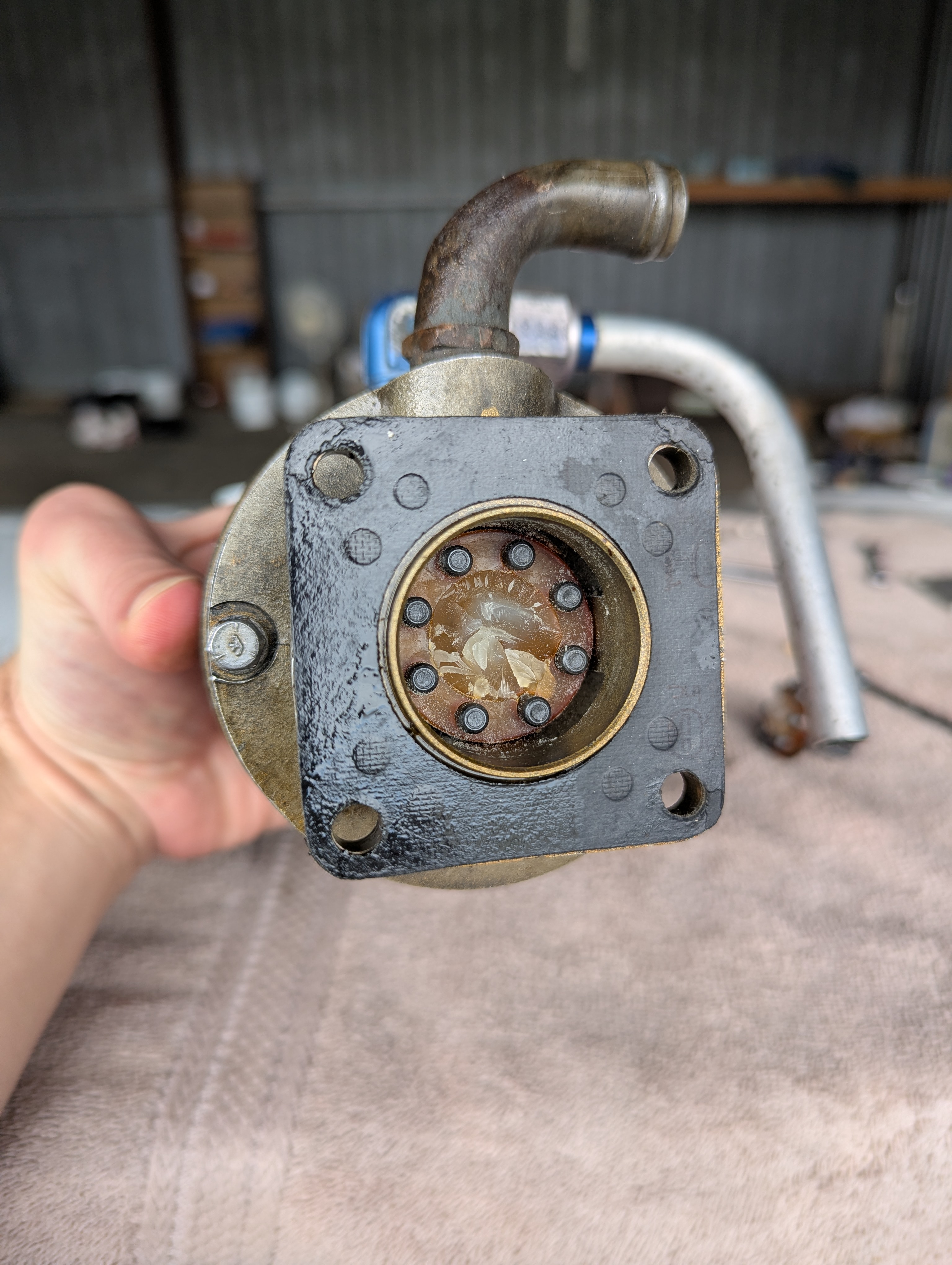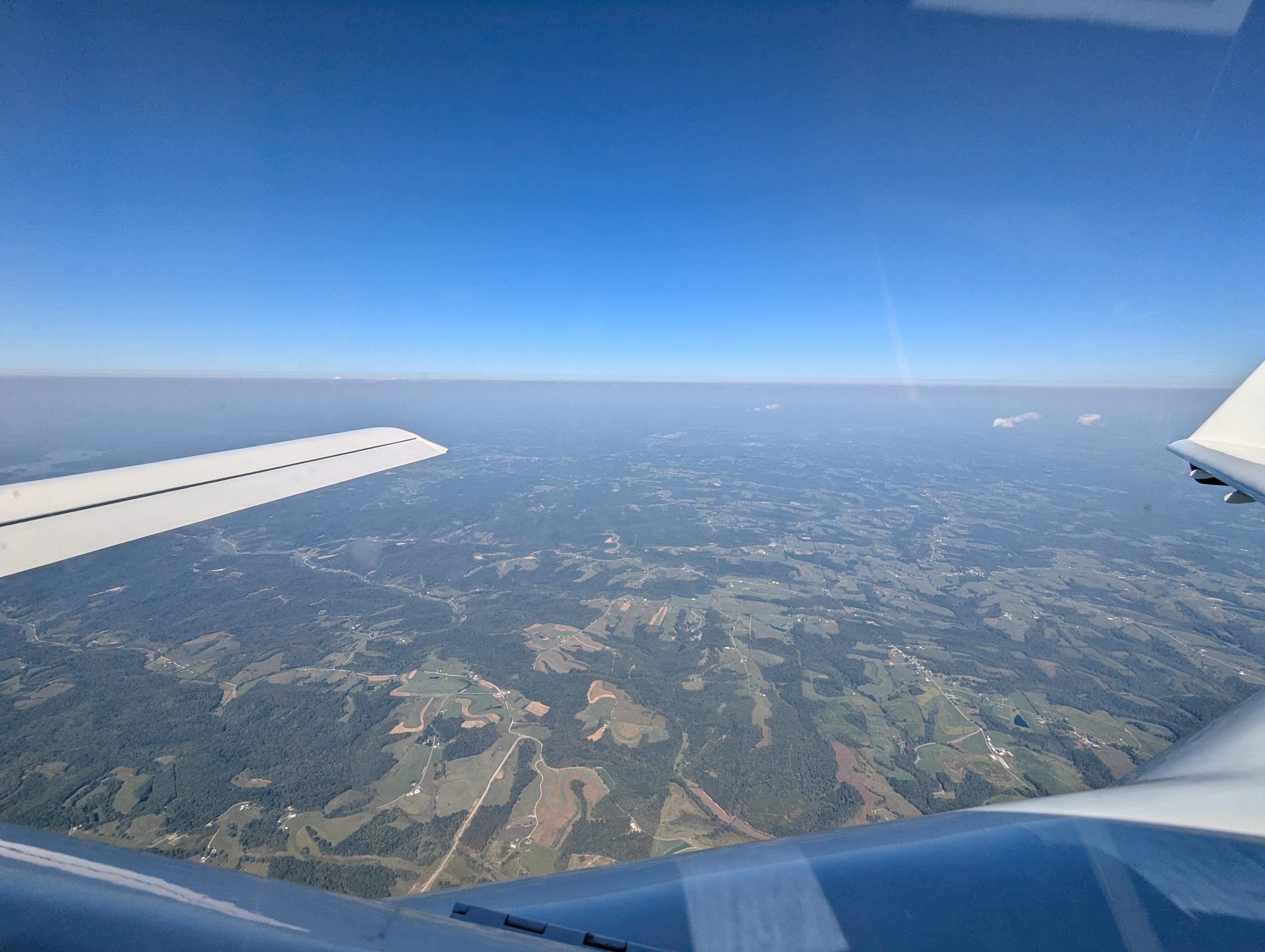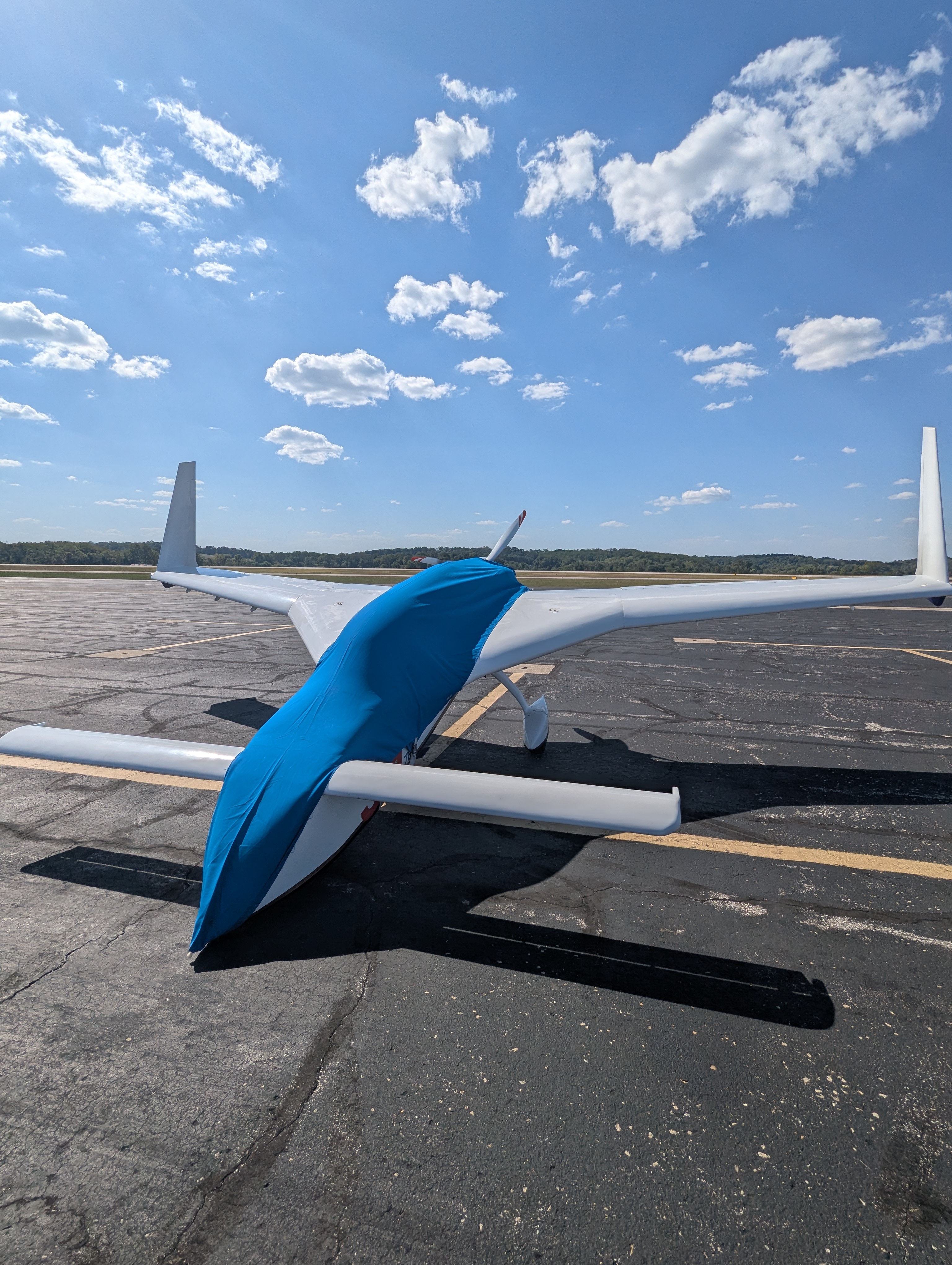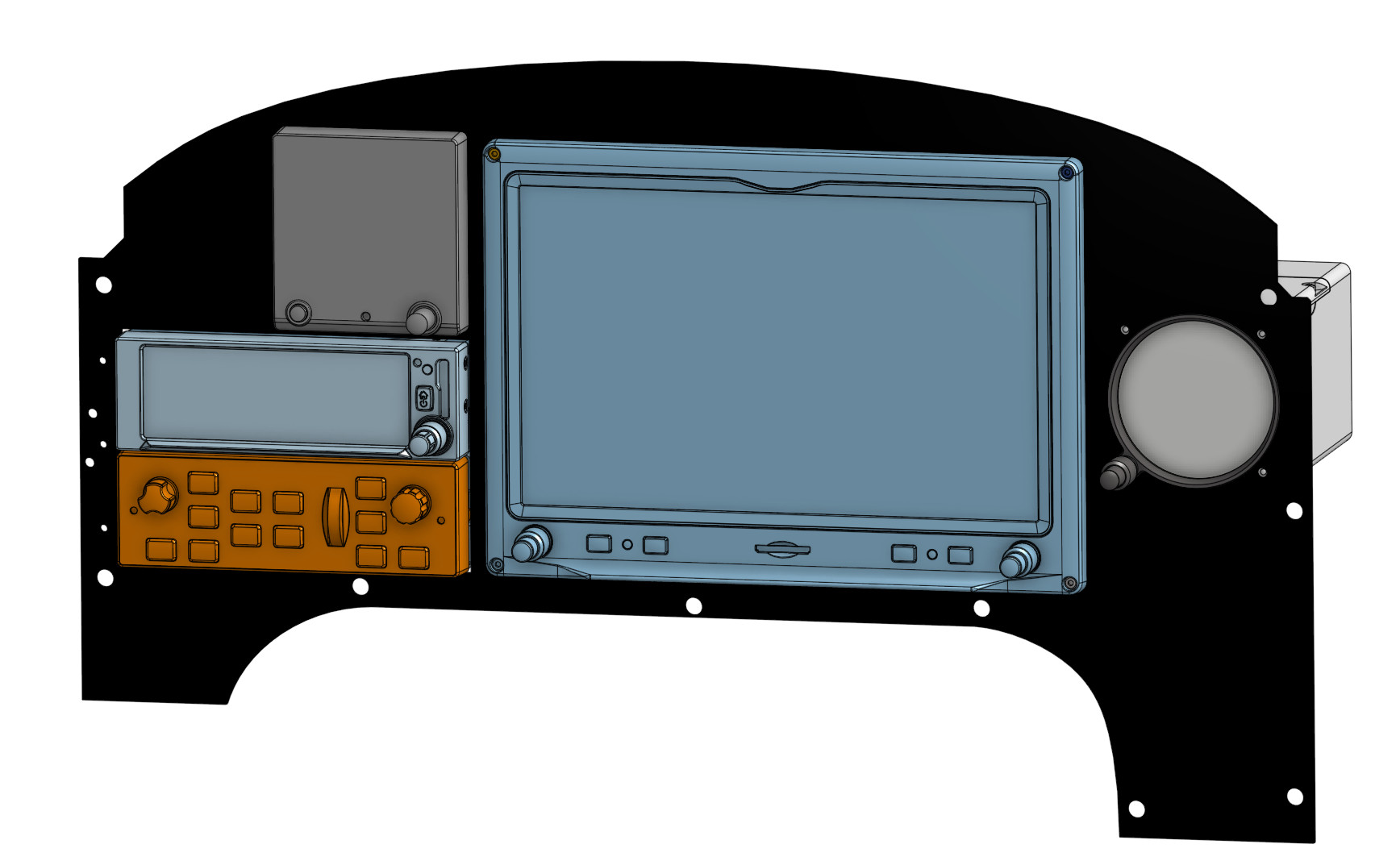
I bought and flew my first airplane home last weekend. I’ve been in the market for an airplane for close to a year now, and after a long wait one of the type, quality, and specs I was looking for became available. I was quick to do an in-depth review of the logbooks, documents, and pictures, make an offer, and arrange a thorough pre-buy inspection. Prior to finishing the deal and flying it for the first time, I also got a demo flight from a coworker who had built one of these planes, and had multiple conversations with experts, flight advisors, and the current owner to prepare myself. The plane I purchased is an experimental amateur built plane designed by Burt Rutan and known as a Long EZ.

I chose this unusual plane for a handful of reasons. In no particular order:
The primary reason for purchasing a plane (beyond the fact that I’m an avid flyer) is for commuting. My fiancee and I are both from the same town where our families still live. It’s an 8-10 hour drive to commute home, an expensive commercial flight that isn’t much faster all said and done, or ~3 hour direct flight to our home-town airport. Tough choice :-)
The existing planes I am able to rent run for $140 to $225 an hour, which makes it difficult to justify for anything other than the occasional trip back home. Considering the fact that we often want to visit for only a few days, none of the options are particularly attractive. Either its a lot of money or a lot of time for a quick trip. Something a little faster, and a little more economical is an attractive prospect.
The reason for going experimental is two-fold. For one, I develop software for avionics mostly designed for the experimental and light certified general aircraft markets. I think it’s not only neat to immerse myself in this world through the rabbit hole of plane ownership, but the idea of owning a plane that I can eventually install the products I work on into is equally exciting. Second, experimental amateur built (EAB) planes tend to be cheaper in a few ways.
Often their up front cost is lower than a comparable certified plane. Certification is a difficult and expensive process almost every step of the way. This combined with a multitude of other factors has really driven up the cost of new certified general aviation planes in the last 30 years. Even GA planes that are 60-80 years old can still run for many tens of thousands of dollars, and you may be getting no where near as much plane for similarly priced EAB.
Additionally pilots of EABs are awarded more privileges when it comes to what they can do with their planes. Being experimental and not having to conform to a type design allows much more freedom for who can make make repairs and how they can be made. Owners can do much more of their own maintenance on an experimental plane, just like one might do for their car, and parts do not necessarily have to be certified or designed for aircraft. Often there is good reason to still use certified products or products at least designed for aviation, but other times there are good reasons not to. For example, my plane has an electronic ignition system that is not certified, but it provides better engine performance and safety than a dual magneto system. This is not to make a case against certification or to say that its the complete wild west as there are still rules and regulations applicable to EABs and plenty of good reasons that certification processes exist.
The Long EZ is a particularly fast and fuel efficient airplane. This is primarily due to the sleek and lightweight design. The engines in many Long EZs are the same as what you may find in a Cessna 150 or 172. These two planes may cruise around 100 kts and consume around 6-8 gallons of fuel per hour (getting around 15 miles per gallon). The same engine (a Lycoming O-320) powers my Long EZ and I can comfortably cruise around 150 kts and get closer to 25 mpg. On my flight back home I was doing close to 30 mpg with a gentle tailwind. The drawback is a narrower fuselage that permits less baggage and only two passengers; however, for our purposes this is not too much a limitation.
Last but not least, safety was a big factor in what kind of plane I chose to pursue. I wanted something with a proven record. Thousands of Long EZs have been built and flown successfully, and the designer, Burt Rutan, has had a long and successful career consisting of many proven designs. The unusual canard design also make the Long EZ “stall proof” in a sense. When a traditional plane stalls, the main wing is not making enough lift to sustain flight, and this typically results in reduced controllability and altitude loss until the stall is recovered. In a Long EZ, the canard stalls before the main wing, and when this happens the nose naturally lowers. By lowering the canard, the angle of attack is reduced. This reduction in angle of attack recovers the aircraft from the stall. So in other words, the Long EZ will naturally recover from a stall and keep flying with minimal altitude or controllability loss.
However, with any EAB airplane design, there are always some differences and unknowns about the plane. Each person who builds an EAB is the manufacturer for that plane, and they can depart from the plans/design as much or as little as they like. Some of these modifications, if they exist can be lost to time, especially if the plane has gone through a few owners throughout its life. In my case, the original builder was the seller which definitely gave me some confidence and ability to ask more questions about its construction. Craftsmanship also varies from builder to builder, and some may have a little more aptitude or attention to detail than others. Because of this, it’s very important to have a thorough pre-buy for any EAB (really any plane, but particularly EABs).
About a month prior to buying my plane, I flew out to meet the owner, take a look at the plane, and shadow a reputable shop as they did a full pre-buy inspection of the airplane. The main purpose of a pre-buy is to find any issues that may pose a significant risk to safety of flight or safety of wallet. Big items like the engine health, airworthiness directives that may mandate expensive maintenance, and structural integrity are big focuses of a pre-buy inspection. Smaller items like cosmetics are less important, but still important to be aware of.
I came out of the pre-buy with a multipage list of “squawks” (issues) to read over, research, and use to inform my decision about whether or not to complete the sale. Obviously I decided to proceed.
There were some items that were more concerning than others. Most concerning to me was the presence of some minimal but visible corrosion in the two older cylinders on the airplane. While not a significant risk to the safety of flight, corrosion will most likely result in the engine needing significant maintenance sooner, and overhauls can get expensive fast. Otherwise, the main findings seemed to be that the plane was in need of some TLC.
After the owner had picked the plane back up, we met at his hangar where we talked about it some more and agreed to a deal. Part of this deal involved a modest price decrease due to the vacuum pump being non-functional. I helped him remove the faulty vacuum pump, and we agreed that we would leave it off since I planned to upgrade and remove the vacuum system anyways.

A month later I had a scheduled one-way flight back to where the plane was based. I arrived on a Friday night, and I met with the seller the following Saturday. We worked on the plane a little more together, mostly so I could have a chance to look over everything thoroughly one more time and ensure that inspections and logbooks were up to date. We addressed a couple small items from the pre-buy inspection, and then talked through my first flight.
I asked him plenty of questions to make sure I knew as much as I could, but then all that was left was to just go for it. Unfortunately there’s not a great way to get flight instruction in these planes, otherwise I would have considered doing that prior to the first flight. However, the good news is that most single engine airplanes fly similarly to other single engine airplanes. I had also been able to get a back seat ride from a coworker in his Long EZ prior to flying out, and I had spoken to a flight advisor who talked to me through his experience buying, owning, and flying a Long EZ.
My first flight went uneventfully. I spent an hour maneuvering north of the airport getting a feel for the controls and characteristics of the plane. When I was ready, I headed back towards the airport and conducted three landings. Overall I felt decently about all three. The first one took me a little by surprise as I didn’t quite have a feel for the sight picture during landing. The second one was a little firmer than I’d have liked, but I didn’t bounce. The third landing went pretty smoothly, but I definitely landed fast.
I taxied back to the hangar where the seller congratulated me, and I was not able to stop smiling. We debriefed about how the flight went, made plans for the following day, and I headed back to the hotel to get some rest.
On Sunday I departed in the late morning after some fog had lifted, and I had a smooth flight back home with gentle tail winds the whole way. I stopped in my home town over night, and then I continued the rest of the way the following day. It took about 7 hours of flying to traverse over 1000 miles, and I only used about 40 gallons of fuel.



I’ve now got the plane parked on the ramp at one of the local airports while I continue waiting for a hangar spot to open up, hopefully in the next few months as I’m nearing the top of the waitlist. I have plans to immediately start on some upgrades for the panel. The plane currently does not have ADS-B out or digital engine monitoring, two big priority items for me. I’ve already made some changes to the original plan, but the initial idea I had was to do a two stage upgrade consisting of a G5, GNX 375, GI 275, and GEA 24 for part one, and follow it with a second set of upgrades to add in a Garmin autopilot with GMC 507 controller, GDU 460, and remote mounted com radio (plus other bits and bobs needed to run everything). Ultimately I decided on something a little different, but I will write a separate post for that as I work on the panel project!
